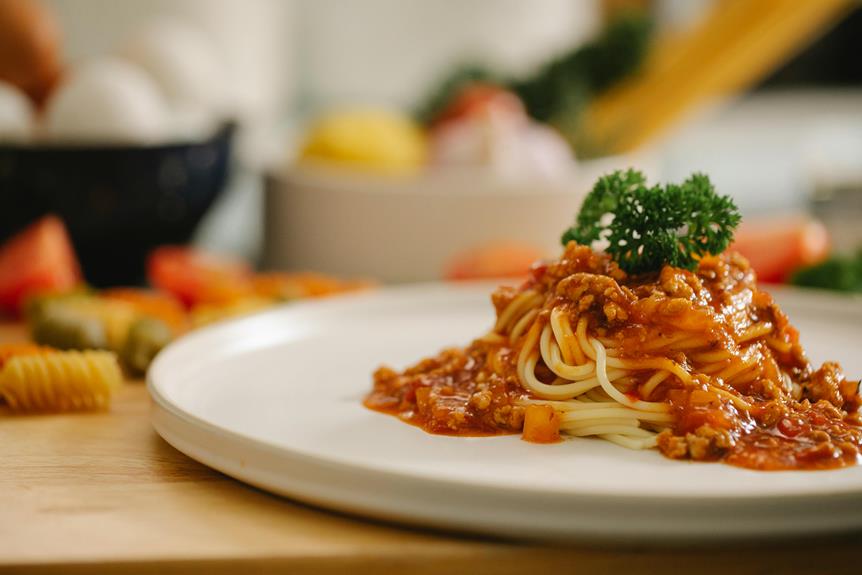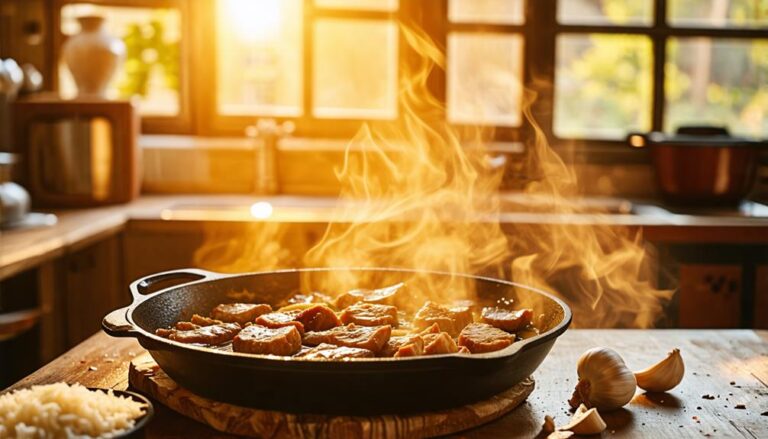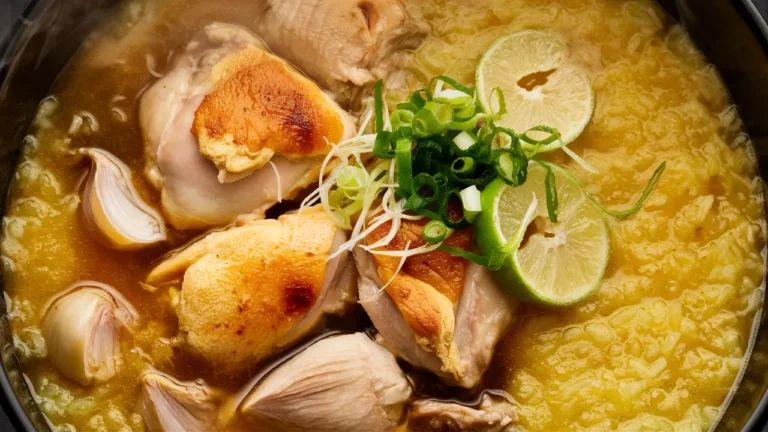Pancit: Exploring the Diverse Noodle Dishes of Philippine Cuisine

You'll enjoy exploring the diverse noodle dishes under the umbrella of Pancit in Filipino cuisine. From Pancit Bihon made with rice vermicelli to Pancit Canton's egg noodles, these dishes are essential in Filipino festivities. Stir-frying techniques and almost smoking hot woks bring out vibrant flavors and crispy textures. Varieties like Pancit Malabon and Pancit Palabok showcase regional twists. Essential ingredients include an array of meats, vegetables, and signature sauces. Pancit symbolizes unity and communal gatherings, deeply embedded in Filipino cultural celebrations. Immerse yourself in each variety to relish the rich culinary heritage and learn how these dishes come to life.
Key Takeaways
- Pancit varieties include Pancit Canton, Pancit Bihon, Pancit Malabon, Pancit Palabok, and Pancit Luglug.
- Essential ingredients for pancit are bihon, sotanghon, Pancit Canton noodles, vegetables, and meats like pork, chicken, and shrimp.
- Cooking techniques involve stir-frying with high heat and quick cooking in a nearly smoking wok, incorporating sauces and seasonings.
- Regional variations such as Pancit Malabon, Pancit Habhab, and Pancit Batil Patung reflect local flavors and traditions.
- Pancit is deeply intertwined with Filipino culture, symbolizing communal gatherings, celebrations, and the heritage of togetherness.
Types of Pancit Noodles
When exploring Filipino cuisine, you'll find that Pancit noodles, including bihon, sotanghon, and Pancit canton, each bring distinct textures and flavors that reflect the rich cultural mosaic of the Philippines.
Pancit bihon, or rice vermicelli, is a staple in many Filipino households. These thin, transparent noodles are often used in Pancit palabok, a dish characterized by its bright orange sauce and delightful toppings. The texture of bihon noodles allows them to soak up flavors, making each bite a burst of umami.
Sotanghon noodles, made from mung bean starch, are another essential type. These glass noodles are commonly featured in soups and stir-fried dishes. Their slippery, gelatinous texture adds a unique mouthfeel, enhancing the dish's overall sensory experience. Sotanghon's ability to absorb and meld with various ingredients highlights the Filipino knack for exploring flavors.
On the other hand, Pancit canton noodles are thicker and chewier, akin to Chinese egg noodles. These flour stick noodles are perfect for hearty stir-fried dishes, absorbing sauces and seasonings effectively. The cultural significance of Pancit canton lies in its versatility, serving as a foundation for many celebratory meals, symbolizing long life and prosperity.
Popular Pancit Varieties
One can't explore Filipino cuisine without delving into the rich array of popular Pancit varieties that highlight the country's diverse culinary heritage. Each type of Pancit brings its own delectable combinations and unique presentations, reflecting the historical origins and cultural significance of various regions in the Philippines.
Pancit Canton, a staple in many Filipino households, is a stir-fried noodle dish made with flour stick noodles, meat, and vegetables. Its roots trace back to Chinese influences, embodying a blend of flavors that have been adapted over centuries.
Pancit Bihon features thin rice noodles stir-fried with meat, shrimp, and vegetables, seasoned with soy sauce and calamansi. This dish's simplicity and delightful taste make it a favorite for many Filipino celebrations.
Pancit Malabon, hailing from Malabon City, is known for its thick rice noodles, seafood, and traditional palabok sauce. The dish's unique presentation, often garnished with hard-boiled eggs and chicharron, is a visual delight.
Pancit Palabok and Pancit Luglug, both featuring a delicious orange sauce and thick rice noodles, are celebrated for their rich shrimp flavors. While Palabok has a broader following, Luglug's Kapampangan roots highlight regional culinary nuances.
Essential Ingredients
Frequently, the key components in Filipino pancit dishes—noodles, various meats like pork, chicken, or shrimp, and an assortment of fresh vegetables—reflect the country's rich culinary history and regional diversity. The noodles serve as the foundation of any pancit dish, with bihon, sotanghon, and Pancit Canton noodles being among the most commonly used. Each kind of noodle brings its distinct texture and taste, contributing to the dish's overall attractiveness.
You'll often find a colorful variety of vegetables in pancit, which not only add vibrancy but also provide a nutritional boost. Typical options include:
- Cabbage
- Carrots
- Bell peppers
- Snap peas
These vegetables, when paired with meats like pork, chicken, or shrimp, create a pleasing blend of flavors and textures. For instance, combining flavorful pork with the sweetness of bell peppers or the crunchiness of snap peas can enhance the entire dish.
When it comes to cooking advice, it's crucial to stir-fry the vegetables just adequately to preserve their crispness, ensuring they complement rather than dominate the noodles and meats. By exploring diverse flavor pairings, you can customize the dish to your liking, creating a truly gratifying pancit experience each time.
Cooking Techniques
Stir-frying, a cornerstone technique in Filipino cuisine, is utilized to achieve the quick and even cooking of pancit dishes, guaranteeing that each ingredient retains its distinct flavor and texture. Historically, this method was influenced by Chinese immigrants who introduced the wok and its unique cooking advantages. Employing high heat and quick cook principles, you'll find that the essence of wok techniques allows for the ideal stir fry secrets: retaining the crunchiness of vegetables and the al dente texture of noodles.
When preparing pancit, you'll start by heating the wok until it's almost smoking. This high heat is essential for searing ingredients quickly, locking in their juices and flavors. Adding oil, you'll first stir-fry proteins like chicken or shrimp, making sure they're cooked through. Next, aromatic ingredients such as garlic and onions are added to lay a flavorful foundation. Vegetables are introduced towards the end to preserve their vibrant colors and crispness.
The noodles, cooked separately to al dente perfection, are then combined with the stir-fried components. Finally, sauces and seasonings are incorporated, allowing the noodles to absorb rich flavors while maintaining their integrity.
Mastering these wok techniques guarantees your pancit dishes are a delightful balance of textures and tastes.
Regional Variations
How do regional variations of pancit reflect the diverse mosaic of the Philippines' culinary landscape? Each region brings its own unique twist, infusing local ingredients and distinct culinary influences into these beloved noodle dishes. It's fascinating to see how cooking techniques and flavor profiles change from one province to another, offering a colorful tapestry of flavors.
Consider these regional variations:
- Pancit Malabon: Known for its seafood-based ingredients, this dish uses flavorful combinations like shrimp, oysters, and squid, and is topped with hard-boiled eggs and chicharrón.
- Pancit Habhab: Originating from Quezon, this version is typically served on a banana leaf and eaten without utensils. The noodles are cooked with local ingredients such as Lucban longganisa (sausage) and vegetables.
- Pancit Batil Patung: Hailing from Tuguegarao, it features a hearty mix of stir-fried noodles, ground meat, and vegetables, with a unique twist of a poached egg on top and a side of soup.
- Pancit Palabok: A dish with a rich, orange sauce made from shrimp broth, crushed pork cracklings, and topped with smoked fish flakes, showcasing a blend of local and foreign culinary influences.
Exploring these regional pancit variations provides a deeper understanding of the rich and varied Filipino culinary heritage.
Serving and Storing
When serving pancit canton, guarantee its flavors with a squeeze of calamansi and pair it with traditional sides like puto or pandesal, reflecting its cultural significance in Philippine gatherings.
To preserve the dish's integrity, store leftovers in an airtight container in the fridge for up to 3 days, but avoid freezing as the noodles can become mushy.
Reheat in the microwave in short intervals to make sure it remains as delightful as when first served.
Perfect Serving Suggestions
To truly appreciate the rich flavors of pancit canton, serve it with a squeeze of calamansi and traditional Filipino sides like puto or pandesal, enhancing both the taste and cultural significance of the dish. These small yet impactful touches bring out the delicious essence of the noodles and the harmony of mixed vegetables and meats.
Consider these tasty toppings for an added layer of texture and taste:
- Crunchy garlic bits: Add a delightful crunch and aromatic depth.
- Diced scallions: Fresh and vibrant, they enhance the visual appeal and flavor.
- Boiled eggs: Slice them and arrange on top for a protein boost and classic look.
- Shrimp or pork slices: These make the dish more substantial and satisfying.
Creative presentations can also elevate your pancit canton experience. Use banana leaves as a natural serving platter to imbue a rustic, traditional feel. Alternatively, try serving portions in individual bowls for a modern, convenient touch.
Storing Leftover Pancit
Properly storing your leftover pancit in an airtight container guarantees it retains its delightful flavors and textures, allowing you to enjoy a taste of Filipino heritage even after the initial meal. With container options ranging from glass to high-quality plastic, choosing the right one ensures that your pancit remains fresh for up to three days in the refrigerator.
Historically, the Filipino tradition of making pancit has been rooted in communal and festive gatherings, making leftover pancit a common occurrence.
To maximize its longevity, it's essential to transfer the noodles into the airtight container as soon as they've cooled down. This helps lock in the moisture and prevent the noodles from drying out. When it comes to flavor preservation, this method is vital. Pancit, with its rich blend of savory flavors, can lose its appeal if not stored properly.
Reheating methods are equally significant. For the best results, reheat your pancit in the microwave using short intervals, stirring in between to ensure even heating. This technique helps maintain the dish's unique texture and flavor, allowing you to relish the essence of Filipino cuisine once more.
Frequently Asked Questions
What Is the Origin of the Word "Pancit"?
The origin of the word 'pancit' lies in its etymology, coming from the Hokkien Chinese term 'pian-e-sit,' meaning 'something conveniently cooked.' Its cultural significance in Filipino cuisine reflects Chinese influence and symbolizes longevity.
How Do Filipino Celebrations Highlight Pancit Dishes?
Filipino celebrations highlight pancit dishes due to their cultural significance on festive occasions. You'll find regional variations showcasing unique ingredients, symbolizing long life and prosperity, making them essential during birthdays, fiestas, and holidays.
Are There Any Health Benefits Associated With Pancit?
You'll find several nutritional benefits in pancit due to its cooking methods. The dish's vegetables, proteins, and noodles provide essential nutrients. Plus, ingredients like garlic and onions add immune-boosting and anti-inflammatory properties, enhancing its health value.
Can Pancit Be Made Gluten-Free?
Yes, you can make pancit gluten-free by using gluten-free alternatives like rice noodles instead of the traditional recipes with wheat noodles. This approach caters to dietary restrictions and offers diverse pancit variations for everyone.
What Are Some Modern Twists on Traditional Pancit Recipes?
You'll find modern twists on traditional pancit recipes through fusion cuisine and innovative recipes like Pancit Carbonara or Pancit Biryani. Culinary trends and unique flavor combinations redefine pancit, making it diverse and exciting for contemporary palates.
Conclusion
By diving into the world of pancit, you've discovered a rich mosaic of noodle dishes that encapsulate the Philippines' history, culture, and culinary ingenuity.
Each variety, from Pancit Canton to Pancit Malabon, tells a story rooted in regional traditions and shared experiences.
Understanding the essential ingredients and diverse cooking techniques deepens your appreciation for this beloved cuisine.
Now, you're well-equipped to explore, cook, and enjoy pancit, preserving its legacy for future generations.






